 |
Humorous, satirical works in pyrography with
color represent a large portion of the varied repertoire of multimedia
artist Keith Seitz,
an Auburn University graduate in Illustration and Graphic Design.
Keith did some silk screen design and for the last eleven years
has been a media specialist for Milliken and Company where he
is a manager of media services working in both 2- and 3-dimensional
computer graphics and web design. |
|
Profile |
|
Although new to pyrographics, Keith already has a very successful recent show to his credit where he says of 12 each of paintings and wood burnings, they almost all sold. At present, he is starting work on several large panels in preparation for another show up in Michigan, and, for his wife, he is working on a table. |
 |
|
Bird in Suit, by Keith Seitz, 1999 |
 |
Keith's curious faces often wrap around the edge of the wood panel, sometimes even the facial features sort of dribbling over the side. Keith says he likes to work in the "direct method". He does no sketching first, but works directly on the wood with the burning tool. His favorite woods are cedar and basswood. To several pieces he has afterwards added paints or dyes (like the ones shown here). Despite his demanding career in the corporate world, Keith has continually showed his art. He says that he likes pyrographics because it is so different from the often cold and sterile computer world. Look for the Keith
Seitz Salon in the Portraits and Paintings Hall of the E-Museum,
too. |
|
Profile |
 |
|
by Jianting Li, 1999 Pyrography on wood panel |
Another newly discovered pyro is Jianting Li whose subtle touch and beautifully executed compositions interpret the Chinese traditional style with mastery. See more of his fine work in animals and landscapes on his website, linked here. Don't forget to send him a note while you're there.
The name of the late artist and architect Benjamín Cañas (1933-1987) has come up more than once to my readers, who have seen some of his work in images in the E-Museum. I am privileged to have known him personally and to have seen many of his now famous paintings in his gracious home before they were placed in private collections and museums. His earlier works (late 1960's and into the 1970's) were abstract in style with strong pre-Columbian elements that are so much a part of the Central American cultural heritage. These earlier works were the ones where he used pyrography in mixed media renderings on paper and on wood panels. His later works were mostly large oil paintings on wood panels in a surrealist style greatly inspired by the writings of Kafka. I have also visited personally two beautifully original churches designed in their entirety by him. The earlier one of them, in the shape of a fish (the symbol used to signify Christ in the early days of Christianity), boasts a striking wrap-around mural depicting the Stations of the Cross, also conceived by Benjamín.
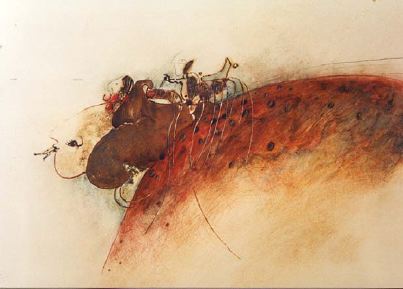 |
|
by Benjamín Cañas Mixed media pyrograph on paper |
Not really aware of how well known Benjamín
Cañas might be, I was most curious when not one but two
queries about him came my way the same day some months ago,
The first was from an acquaintance of his who had bought two of
his earlier paintings at his one-man art show in Washington, DC,
back in 1970. The second query came from a far more unlikely source.
The e-mail was written in Spanish yet originated from Poland!
The sender was requesting biographical data on Benjamín
Cañas to include in a 25-volume Spanish-language encyclopedia
being published in Poland. Now that is not your everyday query.
I decided to do some investigating of my own at that point to
learn who else may have something on the web about my departed
friend.
Apart from being aware of the obvious enjoyment any painting of Benjamín's would bring, I always knew, even back in 1970, when owning one was, unfortunately, not an option for me, that several hundred dollars invested in one would never be unwise.
What I never could have imagined then is that one day people would be writing me, thanks to their internet searches, which would in turn prompt me to do a subsequent search and discover a write-up of an auction where one of Benjamín Cañas' paintings recently sold for an amazing--well, I'll let you guess! Make your best guess, then when you get to the bottom of the article, look for the answer and see how well you did. Or if you want to see the source for my information, click on the auction link, then do a name search with either 'Benjamin' or 'Canas' (no need for the accent marks).
Mixo Sydenham of Pyro Cafe Down Under fame continues to pursue his strategy to gain recognition for the pyrographic art form by doing pyrographs on paper. The intricate pyrograph linked here--Ganesh--is on his Pyro Cafe Down Under website. You won't want to miss it.
A new mystery needs solving: this time the items under scrutiny are a Sofa and Two Chairs
Very little is known about these items, which were bought, according to the owners, at auction some time ago and then reupholstered by them. They would love to know anything and everything about their elaborate pieces. Below is the sofa.
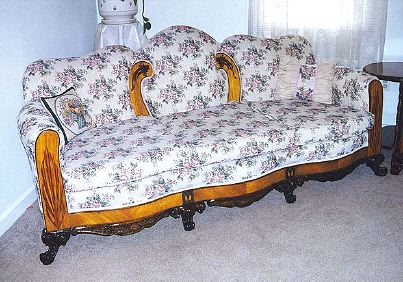 |
|
|
Besides the general question to learn anything more about the origin of this intriguing set of furniture, elaborately designed and decorated with carving, stippling, marquetry, and wood inlay as well,
The subsequent question then is, how does one distinguish? Perhaps some of the carvers and/or pyrographers who read this can answer this question. If you know anything about these unusual pieces or have any ideas on this specific question, they are most welcome--please write! Following are pictures of the chairs and the detail in question.
 |
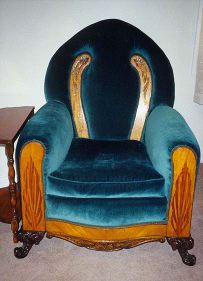 |
|
Short Chair |
Tall Chair |
|
|
Detail of Sofa Back |
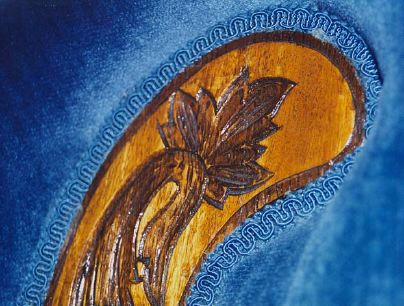 |
|
|
|
Constanca of Portugal has recently joined the IAPA group. Besides her decorative work on boxes of different shapes, she likes doing boat scenes on wood panels. Something you don't see too often these days--she has a decorative floral pattern on a cork panel as well. Check out her website and drop her a line. |
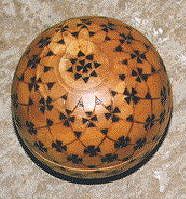 |
| Round Box
by Constanca Portugal Geometric decorative art pyrography on wood box |
A pyrographer new to the internet if not to the art form is pyro Charlotte Varem-Sanders of Canada, whose specialty is charming traditional style pyrography. Check out her website, which she shares with husband Thierry of the Woodcarver Mailing List, and drop her a line. Welcome, Charlotte.
Don't miss a delightful website that will bring a ray of sunshine to your day: Peni's Palette of Colors, which is the website of the talented Peni Powell. Peni is not a pyro, but is a decorative artist who paints on wood and has published books on the subject. Her connection to IAPA and the pyrographic art community is because she is an avid collector of Poker Art, antique pyrography that is also known, among other things, as Flemish Art (mainly because one of the largest companies to produce tools, unfinished wood pieces, designs, etc., for the popular Victorian hobby was called the Flemish Art Co. of New York). Peni has a wonderful and growing collection well worth a visit. You'll also love her website for the gardening section. Peni is also an extraordinary and dedicated gardener who has a home that is the kind they show in Better Homes and Gardens. Go for a nice visit and sign her guestbook. Peni Powell's website is also linked from her own Flemish Art salon in the Antique Hall of the E-Museum, where she has a substantial collection on display as well.
More antiques (and queries from owners of antiques) are turning up all the time in the Antique Hall at the E-Museum, so check back often to see what new discoveries are on display. One of the latest is the unusual piece below, acquired some years ago by Dan Smith of Virginia, USA. This piece was one of the offerings from the Thayer and Chandler Co. of Chicago (the Flemish Art Company's competition) that sold unfinished wood pieces in the early part of this Century with a stamped design on them for hobbyists to woodburn. This item is pictured in the Thayer and Chandler catalogue of that time and is reproduced in the book Burning Passion. by Carole and Richard Smyth. Because it's a larger, more elaborate item and one less commonly found, this firescreen is a real treasure. What a beauty!
 |
|
by unknown artist, circa 1910 Pyroengraving on wood firescreen bearing Charles Dana Gibson designs manufactured by Thayer and Chandler of Chicago, Illinois, USA From the private collection of Dan Smith, Virginia, USA |
Soon after the very first exhibit in the Special Hall of the E-Museum opened (which you read about in the last issue), pyro works for two new exhibits came along and were promptly installed. What made that first one unusual, if you recall, was the fact that the artist, Marie Heerkens, does her pyrography on mushrooms. The next two artists' works were placed in the Special Hall because of the unusual tool they use for their work--and they don't use the same one either!
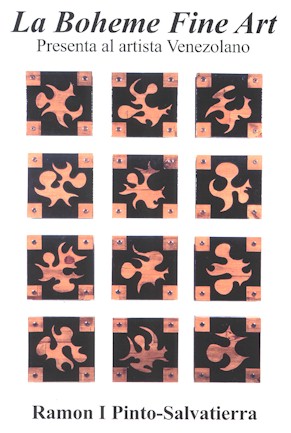 |
|
by Ramon Pinto Blowtorch pyrography on wood panel Invitation courtesy of artist |
Ramon Pinto works with a blowtorch to create bold monochrome abstracts. In July, he opened a one-man show at the La Boheme Fine Art Gallery in Coral Gables, Florida, USA. A new art exhibit with his works opens September 3rd at the South Art Gallery in Miami, Florida, USA. View a salon of Ramon's unique work in the E-Museum and link from there to his website.
 |
|
by Bud Hnetka, 1998 Pyrography on wood panel by means of magnifying lens Scanned image courtesy of the artist |
Still another intriguing exhibit in the Special Hall is that of Bud Hnetka of Canada, whose pyro work on wood panels is limited to months when he can work outdoors because it is done exclusively by means of magnifying lenses utilizing solar rays. The long panel shown here can be viewed in a series of detail images in his E-Museum salon linked to his name. Bud would like to exchange information and ideas with other solar pyros like himself.
|
|
|
Elephant |
Pyrographic artists from the country of South Africa are well represented on the internet. Their specialty is depicting the wildlife of that region interpreted in bold pyrography on leather mounted on wood frames in a rustic style. Names like Benn Voen, Steven Booysen, and Chris Gerber have been linked before from references in past E-Zine articles in this series. Some of their work can be found in the Pyro Cafe Down Under as well.
Kobus van Zyl, whose work is shown above, is another outstanding artist from that country's elite group of wildlife pyros. Visit Werner van Rooyen's website (great background) linked here and see some more fine examples of Kobus' work displayed.
I asked Kobus how pyrography is regarded in South Africa and was pleased when he replied that, although pyrography art exhibits are not common as such, they do, however, take place from time to time. He went on to say that generally pyrographic works on leather are exhibited along with oils, watercolors, and pastels. (Kobus produces work in all these media.) Moreover, he says, "Pyrography...(in South Africa)...is regarded as a top class artform. I'd rather describe it as a status symbol for some people."
IAPA members have been experimenting with a new meeting format that is being very well received. Linked from The Café Flambé, which hosts the IAPA meetings, is the E-Group mailing list, member list, and chat forum. We have Mixo Sydenham to thank for setting it up, and although our first attempts with this new technology were to use the chat room there, we have recently decided to use the mailing list instead as a meeting forum and have ongoing agenda items for two weeks at a time, thereby allowing members to read the topics and reply with comments at their leisure and according to their own schedules.
***Did you guess the auction price for the Benjamín Cañas painting? It went for $200,500.!***
 |
The AuthorKathleen M. Garvey Menéndez
learned her pyrography techniques in Guatemala in 1975-1977.
Her sister, Artist Sharon H. Garvey later joined her there
to collaborate on a pyrography project designed to promote this
art form in the United States by means of a didactic book and
a pyrography tool made by Navarro of Mexico. |
©1999 Kathleen M. Garvey Menéndez, all rights reserved.